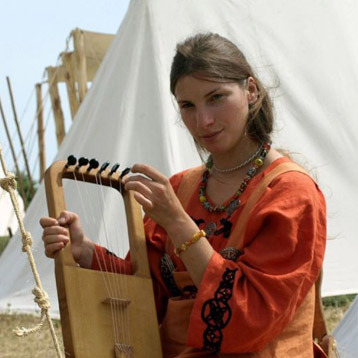Roman and Early Byzantine Glass from Romania and Northern Bulgaria
The present archaeological and technological study of Ancient and Early Byzantine glass from the territories of Romania and northern Bulgaria comprises a larger part regarding the glass production of Dacia and Lower Moesia (Chapter 1), as well as a smaller part on a selection of imported luxury glasses found there (Chapter 2) and on imported glasses of the Sântana de Mureç -Ćernjachov and Carpi cultures, which were subjected to analytic examination (Chapter 3).
Preface
Chapter 1. GLASS PRODUCTION OF DACIA AND LOWER MOESIA IN THE ROMAN AND EARLY BYZANTINE PERIOD 9
1.1. INTRODUCTION
1.1.1. Territorial and chronological scope, research objectives
1.1.2. Brief historical outline
1.1.3. State of research on glass-making in Dacia and Lower Moesia
1.1.4. Sources
1.1.5. Research methods and procedures
1.1.5.1. Research on remains of glass production
1.1.5.2. Research on the glass chemical composition
1.1.6. Selected controversial research issues
1.1.6.1. Issues in glass chemical composition analyses
1.1.6.2. Issues of glass-making organization
1.1.7. Chapter structure
1.2. DACIA
1.2.1. Dacia Superior
1.2.1.1. Sarmizegetusa Regia
1.2.1.2. Colonia Ulpia Traiana Augusta Dacica Sarmizegetusa
1.2.1.3. Tibiscum
1.2.1.4. Apulum
1.2.1.5. Dierna
1.2.2. Dacia Porolissensis
1.2.2.1. Porolissum
1.2.2.2. Other centers
1.2.3. Dacia Inferior, Malvensis
1.2.3.1. Romula-Malva
1.2.3.2. Sucidava
1.2.4. Glass products from outside production assemblages
1.2.4.1. Mĭcia
1.2.4.2. Slăveni
1.2.4.3. Rucăr
1.2.5. Recapitulation
1.3. MOESIA INFERIOR
1.3.1. Lower Moesia, Western part
1.3.1.1. Novae
1.3.1.2. Ulpia Oescus
1.3.1.3. Iatrus
1.3.1.4. Nicopolis ad Istrum
1.3.1.5. Golemanovo Kale
1.3.1.6. Technologically examined production remains from neighbouring provinces
1.3.1.7. Recapitulation
1.3.2. Lower Moesia, Eastern Part (Dobruja)
1.3.2.1. Tomis
1.3.2.2. Ibida
1.3.2.3. Histria
1.3.2.4. Odessos
1.3.2.5. Glasses not from production assemblages: Tomis, Ovidiu, Capidava, Tropaeum Traiani
1.3.2.6 Recapitulation
1.4. Final Remarks
Chapter 2. ROMAN LUXURY GLASS VESSELS FROM DACIA AND LOWER MOESIA SUBJECTED TO TECHNOLOGICAL ANALYSES
2.1. INTRODUCTION
2.2. Cold -decorated vessels
2.2.1. Goblet type E 185?
2.2.2. Bowl type E 216
2.2.3. Bowl type Augst
2.2.4. Other cold-decorated bowls
2.3. Other thin -walled colourless glass vessels
2.4. Recapitulation
Chapter 3. GLASSES FROM THE SÂNTANA DE MUREŞ - ČERNJACHOV AND THE CARPI CULTURES SUBJECTED TO TECHNOLOGICAL ANALYSES
3.1 INTRODUCTION
3.2. Cold -decorated vessels
3.2.1. Thick-walled bowl (no. 87)
3.2.2. Beaker type E 230? (no. 84)
3.2.3. Beaker type E 237 or similar (no. 80 and possibly no. 85)
3.2.4. Beaker type Sântana de Mureş (no. 81)
3.3. Hot -decorated or undecorated vessels
3.3.1. Bowl with a foot, decorated with horizontal threads (no. 86)
3.3.2. Conical-ovoid goblet on a base? (no. 83)
3.3.3. Miniature vessel, semi-open (no. 79)
3.4. Glass pane (no. 82)
3.5. Recapitulation
Appendices 1
Appendix 1 Catalogue of physico -chemically analysed glass finds
Appendix 2 Results of physico -chemical analyses of the glass finds
Polish summary
Bibliography













